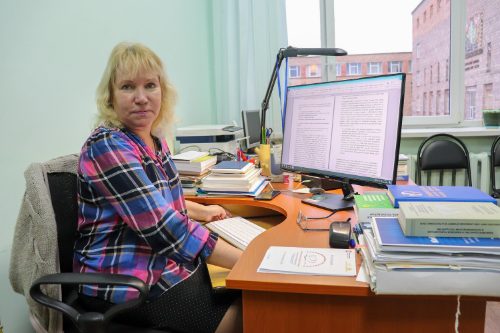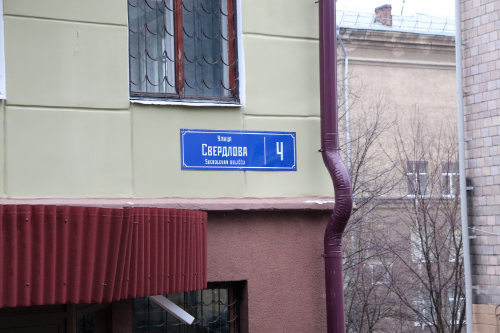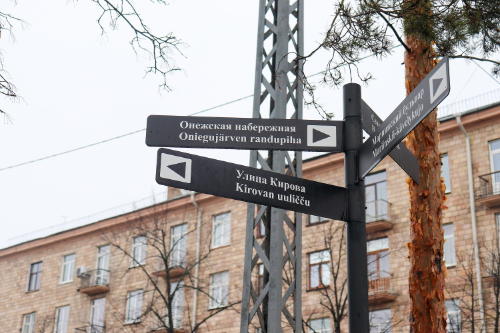– Nowadays, we are increasingly being told that in order to preserve a language, it is necessary not only to hear, speak and write it, but also to see it. This is especially important for the Karelian and Vepsian languages, which for a long time existed only in oral form. In general, Karelian was the language of family, everyday communication. That is why the appearance of signboards, street and road signs in Karelian today is a way not only to preserve it, but also to draw attention to its written form, – the linguist stressed.

Head of Linguistics Section at the Institute of Linguistics, Literature and History KarRC RAS Svetlana Nagurnaya
In the 20th century, the leading (except for Russian) language in Karelia was Finnish, dominating over Karelian and Vepsian. Its use has noticeably declined since the early 1990s: it lost the official language status and the number of its speakers decreased. The revival of Karelian and Vepsian written languages commenced. Visualization of the Karelian language became one of the main lines of the official language policy. Since 2006, Karelian and Vepsian have been added to road and facade signage. The next step was the installation of bilingual street signs in Petrozavodsk.
The experts who prepared the signs informed that the initial translation strategy was to transliterate the main component of the name as much as possible so that it remained recognizable to the citizens, e.g. Lesnaja-uuliččču - Lesnaya (forest) Street. In the course of their work, however, the translators decided on a different principle: to translate whatever is translatable. Preparation of the signs involved not just translation, but also the study of the etymology of the names. The easiest ones to translate were those derived from surnames. Difficulties were encountered with historical terms; sometimes toponymists from ILLH KarRC RAS had to help find the original forms in Karelian and Vepsian.
A peculiarity of Petrozavodsk's language appearance today is “residual trilingualism”: in addition to names in Karelian, there are some bilingual signs in Russian and Finnish still left on older buildings.
Seeking to find out how city residents and visitors feel about the new bilingual signage in Petrozavodsk and the presence of the Karelian language on the streets in general, the researcher conducted a blitz survey among 60 informants of different ages and professions. An overwhelming majority of them stated that Karelian is essential for the language space of the city. At the same time, it turned out not everyone can distinguish Karelian from Finnish. The pros they selected were: «highlights the local color» (70%); «draws attention to the Karelian language» (66 %); «important because we live in Karelia» (62 %). Less than a half remarked that «it catches the eye of tourists» (45 %). Most of the survey participants commented positively on further expansion of the visual space of the Karelian language.
As Svetlana Nagurnaya notes, the presence of Karelian on street signs is of great importance. Citizens associate its visualization with its revival and preservation, showing respect for the culture of the Karelian people, and igniting interest in the Karelian language.

Address plaque in two languages
“Karelian language on city streets is more of a marker of Karelian identity than a way to commodify it and attract the attention of tourists. In the current unfortunate situation of global decline in both the number of Karelians and the share of speakers of the language, “visual bilingualism” can contribute to the formation and preservation of linguistic and ethnic identity, and integration of Karelia into the urban space generates symbolic value”, such are the conclusions of the scientific article.
Scientists remark that a typical situation for most “small” languages today is that language is more of a symbol of unity with the people than a real means of communication. Population census data show that people recognize a language as their native one, even though they don't speak it.
In addition, Svetlana Nagurnaya and toponymist Ekaterina Zakharova conducted a joint study of names in Karelian, as well as in Vepsian and Finnish in the commercial sphere. Such names are booming today: tourist sites, restaurants and cafes, menu items, foods, enterprises, workshops, residential complexes, etc. A sociological survey among 225 residents of the republic showed that a majority (77.8%) fancy such naming. More than 90% were in favor of promoting brands and products in the Karelian language.
However, as linguists point out, modern commercial nomination in Karelian is an uncontrolled naming activity which pursues marketing goals: promotion, branding. Such names quite often diverge from linguistic norms. Many are made with errors: sounds are rendered incorrectly, place names are used improperly, spelling and grammar are often wrong, for example, the order of simplexes within a composite word. At times, this leads to a distortion of the original meaning of the name. Errors occur even in the names of brands that receive government support.
– Unfortunately, there is currently no regulation of this sphere. The survey has shown however that correct spelling of the name is important to people. To preserve the regional cultural specificity it is necessary to consult experts in the naming process, possibly certification is needed. For now, to avoid mistakes, one can contact us at the Institute of Linguistic, Literature and History KarRC RAS, – summarized Svetlana Nagurnaya.




